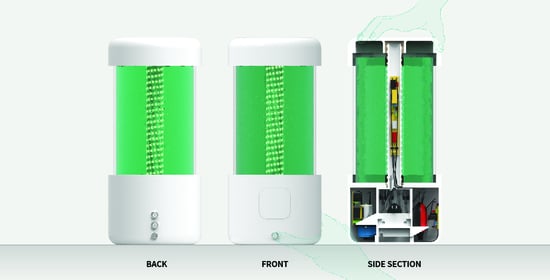Microalgae as Future Superfoods: Fostering Adoption through Practice-Based Design Research
Abstract
1. Introduction
2. Background
2.1. Novel Superfoods
- Type: synthetic or natural.
- Presence in diets: if the food is already present in today’s diets or not and if so, its diffusion.
- Nutritional value: the amount of protein in percentage.
- Acceptance: the degree of acceptability. For example, the appearance of insects could be a barrier to adoption, as well as the atypical color of microalgae.
- Palatability: if the food taste is overall pleasant, or if it may be an obstacle to the diffusion.
- Ethical/Cultural issues: the production or consumption of particular foods could be taboo in some cultures and religions and thus carry ethical implications (e.g., consumption of lab-grown meat).
- Production price: current production price, ranging from affordable to very expensive (where 1 = very expensive and 4 = affordable). This data does not refer to a particular regional area.
- Consumer price: current consumer retail price, ranging from affordable to very expensive (where 1 = very expensive and 4 = affordable). This data does not refer to a particular regional area.
- Processing difficulty: the number of operations needed and their complexity, ranging from very easy to very difficult (where 1 = very difficult and 4 = very easy).
- Sustainability: it includes the environmental sustainability of production and processing methods (including industrial processing), or any benefits and downsides.
- Chance of diffusion: the possibility that the product will become part of daily diets in the coming years, according to current scientific research, consumers’ perception, present market dynamics, and forecasts.
2.2. Spirulina: A Solution to Food Shortage
Food Safety Aspects
2.3. Design and Microalgae
3. Research Method
- Fill the practice gaps.
- Leverage innovative design possibilities.
- Experiment with the design of new technical solutions.
- Create one or more devices for Spirulina production food use.
- Hypothesize innovative product-service systems which use microalgae as a vector for healthy and sustainable growth.
- Test and validate the results to guarantee scientific rigor and objectivity.
- Define a theoretical framework.
3.1. Case Studies Analysis
- Main scope: The primary function of the device.
- Dimensions: The physical dimensions of the product, ranging from contained to substantial, where 1 = substantial and 4 = contained.
- Photobioreactor (PBR) shape: The shape of the production tank (flat-panel, tubular, tank, etc.).
- Production system: Whether the system is open or closed.
- Harvesting system: Typology and mechanism of the harvesting system.
- Productivity: The relative amount of biomass produced in a given timeframe.
- Usability: Ease of use or high-grade performances.
- Maintainability: If the product can perform with minimum maintenance, or if the maintenance is easy to accomplish (e.g., cleaning the tank).
- Cost-effectiveness: The production/manufacturing/replicability price given the biomass productivity.
- Open-source: Whether the project is available in open-source collaboration and peer-production is incentivized.
3.2. Experiment
- practical hands-on with a microalgae culture;
- comprehension of the farming process;
- identification of potential troubles for non-experts growers;
- supply of the necessary components for the construction of a photobioreactor;
- gaining insights on the operational requirements of a photobioreactor.
3.3. Survey
- collect quantitative data through the involvement of a large pool of people;
- understand food purchase behaviors and eating routines;
- gaining insights into consumers values;
- explore participants’ propensity to change food habits, and try new foods;
- assess their knowledge about microalgae;
- arouse their curiosity in participating in thematic tasting sessions;
- evaluate the interest in cultivating microalgae.
3.4. Workshop
- provide invitees with fundamental information about the benefits of microalgae and how to cultivate Spirulina;
- understanding their interest in consuming or harvesting microalgae for food use;
- get quantitative data on the palatability of proposed recipes;
- validate the results of the online survey;
- gaining insights for the design of product-service systems involving microalgae.
3.4.1. Tasting Session
3.4.2. Design Session
3.5. Product Development
3.5.1. A Home Device
3.5.2. A Modular Public Installation
4. Results
4.1. The Algae Grower
- an upper cover to protect the culture from external contamination;
- a base for the tank, perforated to allow the passage of water and air;
- the support for the internal components (e.g., air and water pumps, electric boards). This part consists of 5 pieces, connected by interlocking. It also holds the drawer for collecting Spirulina;
- the drawer, which can be split into parts, and its track slides;
- the outer shell of the lower main body, with openings for the buttons and the drawer.
Validation Tests
4.2. The Algae Station
- Dry Spirulina vending machine: it stores and distributes dry Spirulina-based food products processed by third parties (restaurants, bakeries, and other local businesses). Users can purchase products through a touchscreen. When not in use, the monitor shows educational videos in the loop, illustrating the benefits of microalgae and the positive effects of urban production. This module can operate independently and is the minimum configuration of the Algae Station.
- Fresh Spirulina vending machine: it distributes fresh Spirulina. The module works alongside one or more photobioreactors (module 3). The external appearance is very similar to that of module 1. Internally, an automatic pump system separates the algal biomass from the water, rich in nutrients, through one or more filters. Users can fill their bottles with fresh Spirulina.
- Photobioreactor: it guarantees biomass production. The module consists of a large, high-quality transparent tubular tank. A low consumption lighting system, which provides light and heats the culture, is installed inside each tube. Multiple photobioreactors can be placed side by side to produce more biomass. The tanks are connected to module 2, which also contains the electronic components needed for their operation. Figure 9 shows the Algae Station configuration with a fresh Spirulina vending machine and a photobioreactor module.
Values behind the Physical Product
4.3. Theoretical Framework
5. Discussion
6. Conclusions
Author Contributions
Funding
Institutional Review Board Statement
Informed Consent Statement
Data Availability Statement
Acknowledgments
Conflicts of Interest
Appendix A
| Project Name | Designer(s) | Place | Period | |
|---|---|---|---|---|
| 1 | Flood© | Mathieu Lehanneur | Paris, France | May 2008 |
| 2 | Symbiosis | Jelte van Abbema | Wageningen, The Netherlands | October 2009 |
| 3 | Latro Lamp | Mike Thompson | Eindhoven, The Netherlands | June 2010 |
| 4 | Algae-graphies | Lia Giraud | Paris, France | March 2011 |
| 5 | Moss Table | Peralta, Driver, & Bombelli | Cambridge, UK | October 2011 |
| 6 | Algae Curtain | Loop.pH | Lille, France | October 2012 |
| 7 | Eco-friendly Lamp | Pierre Calleja | Libourne, France | April 2013 |
| 8 | Algaerium Bioprinter | Marin Sawa | London, UK | July 2013 |
| 9 | Dino Pet | Yonder Biology | San Diego, CA, USA | August 2013 |
| 10 | Algaemy | Blond & Bieber | Berlin, Germany | 2014, - |
| 11 | Living Things | Douenias & Frier | Pittsburgh, PA, USA | May 2015 |
| 12 | Farma | William Patrick | Cambridge, MA, USA | December 2015 |
| 13 | Timelapse Ink | Living Ink | Fort Collins, CO, USA | April 2016 |
| 14 | CMYKA | Leon Brown | Edinburgh, UK | December 2016 |
| 15 | Exhale Bionic Chandelier | Julian Melchiorri | London, UK | September 2017 |
| 16 | 3D Bakery | Klarenbeek & Dros | Zaandam, The Netherlands | November 2017 |
| 17 | Spirugrow | Bentur | Pordenone, Italy | January 2018 |
| 18 | Carbon Eaters | PUMA & MIT Design Lab | Milan, Italy | April 2018 |
| 19 | Symbiont | Andriana Nassou | London, UK | July 2018 |
| 20 | The Coral | Hyunseok An | Providence, Rhode Island | June 2019 |
Appendix B
| Element | Specifications | Model |
|---|---|---|
| Transparent glass aquarium | 10 L, 295 × 200 × 215 mm | SUNSUN HRK-300 |
| LED lamp | Easy clip-on support, movable mechanism | AMD-D2/4W |
| Air pump | 4 W, 2 air outlets | SUNSUN CT-402 |
| Air hose | 150 mm | - |
| Bubble tube | Stainless steel, 300 mm | - |
| Digital thermometer | Battery-powered, submersible probe | SUNSUN WDJ-004 |
| Aquarium heater | 25 W, submersible, range 18–32 °C | SUNSUN GB-25B |
| Harvesting sieve | Circular shaped, 150 mm | - |
| Beaker | 1 L | - |
| Secchi stick | - | - |
| pH meter | - | - |
| Spirulina culture | 500 mL | - |
| Culture nutrients | Modified formula f/2 | |
| Culture salts | 2 bags, 50 mL each | - |
Appendix C
| No. | Element | Specifications | Model |
|---|---|---|---|
| 1 | Acrylic Tube | Transparent, external ∅ 160 mm, length 250 mm, thickness 5 mm | - |
| 1 | Acrylic Tube | Transparent, external ∅ 35 mm, length 270 mm, thickness 2 mm | - |
| 1 | PVC Tube | Matte white, external ∅ 25 mm, length 280 mm, thickness 1.5 mm | - |
| 1 | LED Strip | Warm white, adhesive, length ~2 m, 18 W/m | |
| 2 | Water Pumps | 6W, peristaltic, medical grade | KAMOER NK- PDCS10 |
| 2 | Aeration Pumps | Ultra-quiet, 1.5 W | SUNSUN QB-104B |
| 3 | Check Valves | One-way | - |
| 4 | Pipe Connectors | Quick-screw, straight-through and T-type | - |
| 1 | Magnetic Buckle | 48–58 mm stroke | QUFEN 156484486389635 |
| 2 | Acrylic Rods | Transparent, ∅ 5 mm, length 94 mm | - |
| 4 | Electric Boards | - | - |
| 3 | Button Switchers | Metal, self-locking, waterproof | RONGYUHUAFU 2016010305922942 |
| 1 | DC Power Plug | Socket connector | TELESKY DC-099 |
| 3 | Magnets | High-strength neodymium, with M5 screw hole | - |
| 1 | Filter Cloth | Nylon mesh, 38/106 μm mesh | - |
| 1 | Gasket | Silicone, thickness 2 mm | - |
| - | Screws and Bolts | M5 | - |
| - | Waterlines/Airlines | Soft plastic, ∅ 5 mm | - |
| - | Cabling | - | - |
References
- Oxfam. The Hunger Virus: How COVID-19 Is Fuelling Hunger in a Hungry World. Available online: https://oxfamilibrary.openrepository.com/bitstream/handle/10546/621023/mb-the-hunger-virus-090720-en.pdf (accessed on 14 January 2021).
- Cui, K.; Shoemaker, S.P. A Look at Food Security in China. NPJ Sci. Food 2018, 2, 1–2. [Google Scholar] [CrossRef] [PubMed]
- UN. Transforming Our World: The 2030 Agenda for Sustainable Development. Available online: https://www.un.org/ga/search/view_doc.asp?symbol=A/RES/70/1&Lang=E (accessed on 14 January 2021).
- Khush, G.S. Green Revolution: The Way Forward. Nat. Rev. Genet. 2001, 2, 815–822. [Google Scholar] [CrossRef]
- Tilman, D. The Greening of the Green Revolution. Nature 1998, 396, 211–212. [Google Scholar] [CrossRef]
- Lynch, J.P. Roots of the Second Green Revolution. Aust. J. Bot. 2007, 55, 493–512. [Google Scholar] [CrossRef]
- Foley, J. A Five-Step Plan to Feed the World. Available online: https://www.nationalgeographic.com/foodfeatures/feeding-9-billion/ (accessed on 16 January 2021).
- Hendrich, S. Novel foods. In Encyclopedia of Food and Health; Caballero, B., Finglas, P.M., Toldrá, F., Eds.; Academic Press: Cambridge, MA, USA, 2016; ISBN 9780-1238-4947-2. [Google Scholar]
- Meyerding, S.G.H.; Kürzdörfer, A.; Gassler, B. Consumer Preferences for Superfood Ingredients—The Case of Bread in Germany. Sustainability 2018, 10, 4667. [Google Scholar] [CrossRef]
- Estell, M.; Hughes, J.; Grafenauer, S. Plant Protein and Plant-Based Meat Alternatives: Consumer and Nutrition Professional Attitudes and Perceptions. Sustainability 2021, 13, 1478. [Google Scholar] [CrossRef]
- Soylent. Available online: https://soylent.com (accessed on 21 February 2021).
- Fogliano, V. Food Design: Quality Matters! Wageningen University: Wageningen, The Netherlands, 2014; ISBN 9789-4617-3977-3. [Google Scholar]
- Alvaro, C. Lab-Grown Meat and Veganism: A Virtue-Oriented Perspective. J. Agric. Environ. Ethics 2019, 32, 127–141. [Google Scholar] [CrossRef]
- CBI. Product Factsheet—Superfoods in Europe. Available online: https://fdocuments.us/document/product-factsheet-superfoods-in-europe (accessed on 19 January 2021).
- Schiemer, C.; Halloran, A.; Jespersen, K.; Kaukua, P. Marketing insects: Superfood or solution-food. In Edible Insects in Sustainable Food Systems; Halloran, A., Flore, R., Vantomme, P., Roos, N., Eds.; Springer Nature: Amsterdam, The Netherlands, 2018; ISBN 978-3-319-74011-9. [Google Scholar]
- Tomaselli, L. The microalgal cell. In Handbook of Microalgal Culture: Biotechnology and Applied Phycology; Richmond, A., Ed.; Blackwell Science: Oxford, UK, 2004; ISBN 9780632059539. [Google Scholar]
- Ciferri, O. Spirulina, the Edible Microorganism. Microbiol. Rev. 1983, 47, 551–578. [Google Scholar] [CrossRef]
- Henrikson, R. Spirulina: World Food, How This Micro Algae Can Transform Your Health and Our Planet; Rorore Enterprises: Maui, HI, USA, 2010; ISBN 1453766987. [Google Scholar]
- Wikfors, H.G.; Ohno, M. Impact of Algal Research in Aquaculture. J. Phycol. 2001, 37, 968–974. [Google Scholar] [CrossRef]
- Jung, F.; Krüger-Genge, A.; Waldeck, P.; Küpper, J.-H. Spirulina Platensis, a Super Food? J. Cell. Biotechnol. 2019, 5, 43–54. [Google Scholar] [CrossRef]
- Sánchez, M.; Bernal-Castillo, J.; Rozo, C.; Rodríguez, I. Spirulina (Arthrospira): An Edible Microorganism. A Review. Univ. Sci. 2003, 8, 7–24. [Google Scholar] [CrossRef]
- Henrikson, R. Algae Microfarms; Ronore Enterprises: Richmond, VA, USA, 2013; ISBN 148396826X. [Google Scholar]
- Ponce López, E. Superalimento Para un Mundo en Crisis: Spirulina a Bajo Costo. Idesia 2013, 31, 135–139. [Google Scholar] [CrossRef]
- FAO. The State of Food and Agriculture. 1947. Available online: http://www.fao.org/3/ap635e/ap635e.pdf (accessed on 10 January 2021).
- Belasco, W. Algae Burgers for a Hungry World? The Rise and Fall of Chlorella Cuisine. Technol. Cult. 1997, 38, 608–634. [Google Scholar] [CrossRef]
- Paddock, M.B. Microalgae Wastewater Treatment: A Brief History. Preprints 2019. [Google Scholar] [CrossRef]
- Sasson, A. Microalgal biotechnologies: Recent developments and prospects for developing countries. In Proceedings of the Asia-Pacific Marine Biotechnology Conference and Asia-Pacific Conference on Algal Biotechnology, Phuket, Thailand, 7–10 May 1997; pp. 11–31. [Google Scholar]
- Abdulqader, G.; Barsanti, L.; Tredici, M.R. Harvest of Arthrospira Platensis from Lake Kossorom (Chad) and its Household Usage Among the Kanembu. J. Appl. Phycol. 2000, 12, 493–498. [Google Scholar] [CrossRef]
- Piccolo, A. Spirulina—A Livelihood and a Business Venture. Available online: http://www.fao.org/3/a-az386e.pdf (accessed on 10 January 2021).
- Habib, M.A.B.; Parvin, M.; Huntington, T.C.; Hasan, M.R. A Review on Culture, Production and Use of Spirulina as Food for Humans and Feeds for Domestic Animals and Fish. Available online: http://www.fao.org/3/i0424e/i0424e00.pdf (accessed on 20 February 2021).
- Bobescu, E.; Bălan, A.; Moga, M.A.; Teodorescu, A.; Mitrică, M.; Dima, L. Are There Any Beneficial Effects of Spirulina Supplementation for Metabolic Syndrome Components in Postmenopausal Women? Mar. Drugs 2020, 18, 651. [Google Scholar] [CrossRef] [PubMed]
- Al-Dhabi, N.A. Heavy Metal Analysis in Commercial Spirulina Products for Human Consumption. Saudi J. Biol. Sci. 2013, 20, 383–388. [Google Scholar] [CrossRef]
- Myers, W. Bio Design: Nature + Science + Creativity; MoMA: New York, NY, USA, 2018; ISBN 1633450716. [Google Scholar]
- Lee, C.; Lee, H.; Kim, O.B. Biocement Fabrication and Design Application for a Sustainable Urban Area. Sustainability 2018, 10, 4079. [Google Scholar] [CrossRef]
- Correia Carreira, S.; Begum, R.; Perriman, A.W. 3D Bioprinting: The Emergence of Programmable Biodesign. Adv. Healthc. Mater. 2019, 9, 1900554. [Google Scholar] [CrossRef]
- Vallas, T.; Courard, L. Using Nature in Architecture: Building a Living House with Mycelium and Trees. Front. Archit. Res. 2017, 6, 318–328. [Google Scholar] [CrossRef]
- SPACE10. Future Food Today; Frame: Amsterdam, The Netherlands, 2019; ISBN 978-9492311405. [Google Scholar]
- Twilley, N. Algae Caviar, Anyone? What We’ll Eat on the Journey to Mars. Available online: https://www.wired.com/story/space-food-what-will-keep-us-human/ (accessed on 18 January 2021).
- Muratovski, G. Research for Designers: A Guide to Methods and Practice; SAGE: London, UK, 2016; ISBN 1446275140. [Google Scholar]
- Candy, L. Practice-Based Research: A Guide. Available online: https://www.creativityandcognition.com/resources/PBR%20Guide-1.1-2006.pdf (accessed on 10 January 2021).
- Peruccio, P.P.; Vrenna, M. Design and Microalgae. Sustainable Systems for Cities. Agathón 2019, 2, 218–227. [Google Scholar] [CrossRef]
- Yin, R.K.; Davis, D. Adding New Dimensions to Case Study Evaluations: The Case of Evaluating Comprehensive Reforms. New Dir. Eval. 2007, 113, 75–93. [Google Scholar] [CrossRef]
- Singh, R.N.; Sharma, S. Development of Suitable Photobioreactor for Algae Production—A Review. Renew. Sust. Energ. Rev. 2012, 16, 2347–2353. [Google Scholar] [CrossRef]
- Moore, M. China Now Eats Twice as Much Meat as the United States. Available online: https://www.telegraph.co.uk/news/worldnews/asia/china/9605048/China-now-eats-twice-as-much-meat-as-the-United-States.html (accessed on 30 December 2020).
- Emili, S. Designing Product-Service Systems Applied to Distributed Renewable Energy in Low-Income and Developing Contexts: A Strategic Design Toolkit. Ph.D. Thesis, Brunel University London, London, UK, 2017. [Google Scholar]
- Ciribini, G. Tecnologia e Progetto: Argomenti di Cultura Tecnologica della Progettazione; Celid: Turin, Italy, 1984; ISBN 8876610804. [Google Scholar]
- Vrenna, M. Algae Grower. Available online: https://projects.fablabs.io/@mauriziovrenna/algae-grower (accessed on 6 January 2021).
- Gnecchi, N. Q&A with Maurizio Vrenna, Creator of the Algae Grower. Available online: https://wikifactory.com/+wikifactory/stories/qa-with-maurizio-vrenna-creator-of-the-algae-grower (accessed on 7 January 2021).
- Katsikopoulou, M. Algae Grower Home Device Can Satisfy Average Adult’s Daily Nutritional Needs. Available online: https://www.designboom.com/design/algae-grower-home-device-average-adult-daily-nutritional-needs-07-13-2020/ (accessed on 7 January 2021).
- Tabi Labo. For Stylish Interiors! “Spirulina Culture Kit” That You Can Do at Home. Available online: https://tabi-labo.com/296358/wt-algae-grower (accessed on 7 January 2021).
- Mennen, R. Innovation of the Day. Algae Grower. Available online: https://info.trendwatching.com/innovation-of-the-day-the-algae-grower-simplifies-the-process-of-growing-spirulina-at-home (accessed on 7 January 2021).
- Griffa, C.; Vissio, A. WaterLilly: Story of an Architectural Photobioreactor. Available online: https://drive.google.com/file/d/1VxFkWDO5fkZywy4yXEuUUz-_W1tfs3Vh/view (accessed on 3 January 2021).
- Bautista, T. What Ever Happened to the Bread Machine? Available online: https://www.tastecooking.com/ever-happened-bread-machine/ (accessed on 30 January 2021).
- Raasch, C.; Herstatt, C.; Balka, K. On the Open Design of Tangible Goods. R. D. Manag. 2009, 39, 382–393. [Google Scholar] [CrossRef]
- Castelar, B.; (Università degli Studi di Torino, Turin, Italy). Personal communication, 2020.
- Tuji, A.; (National Museum of Nature and Science, Amakubo, Japan). Personal communication, 2020.
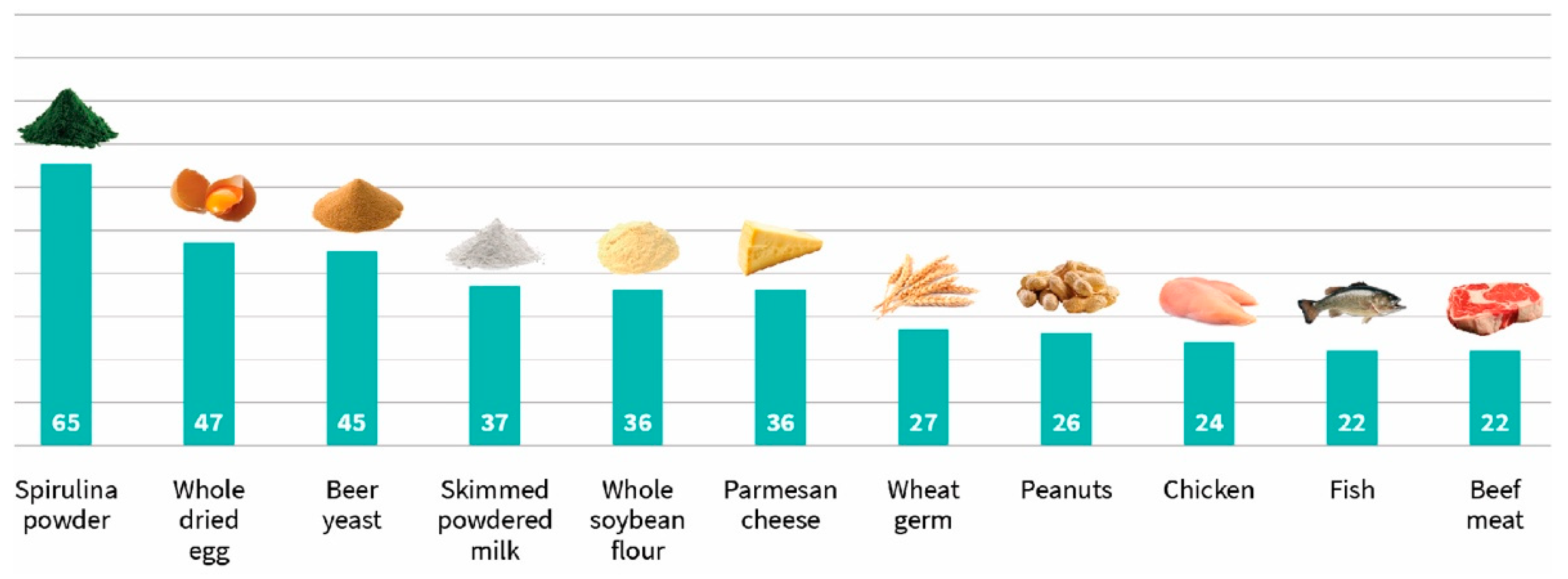
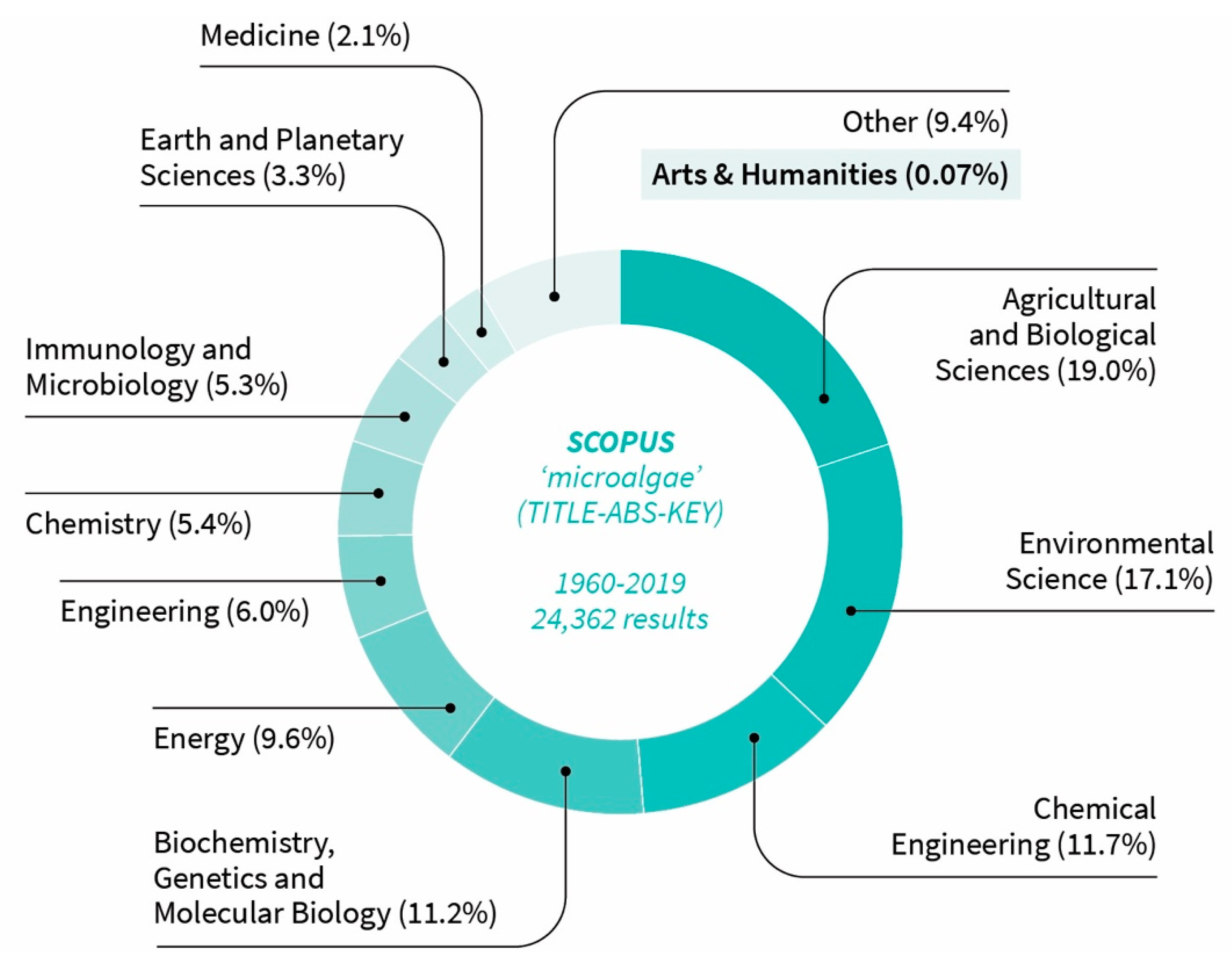
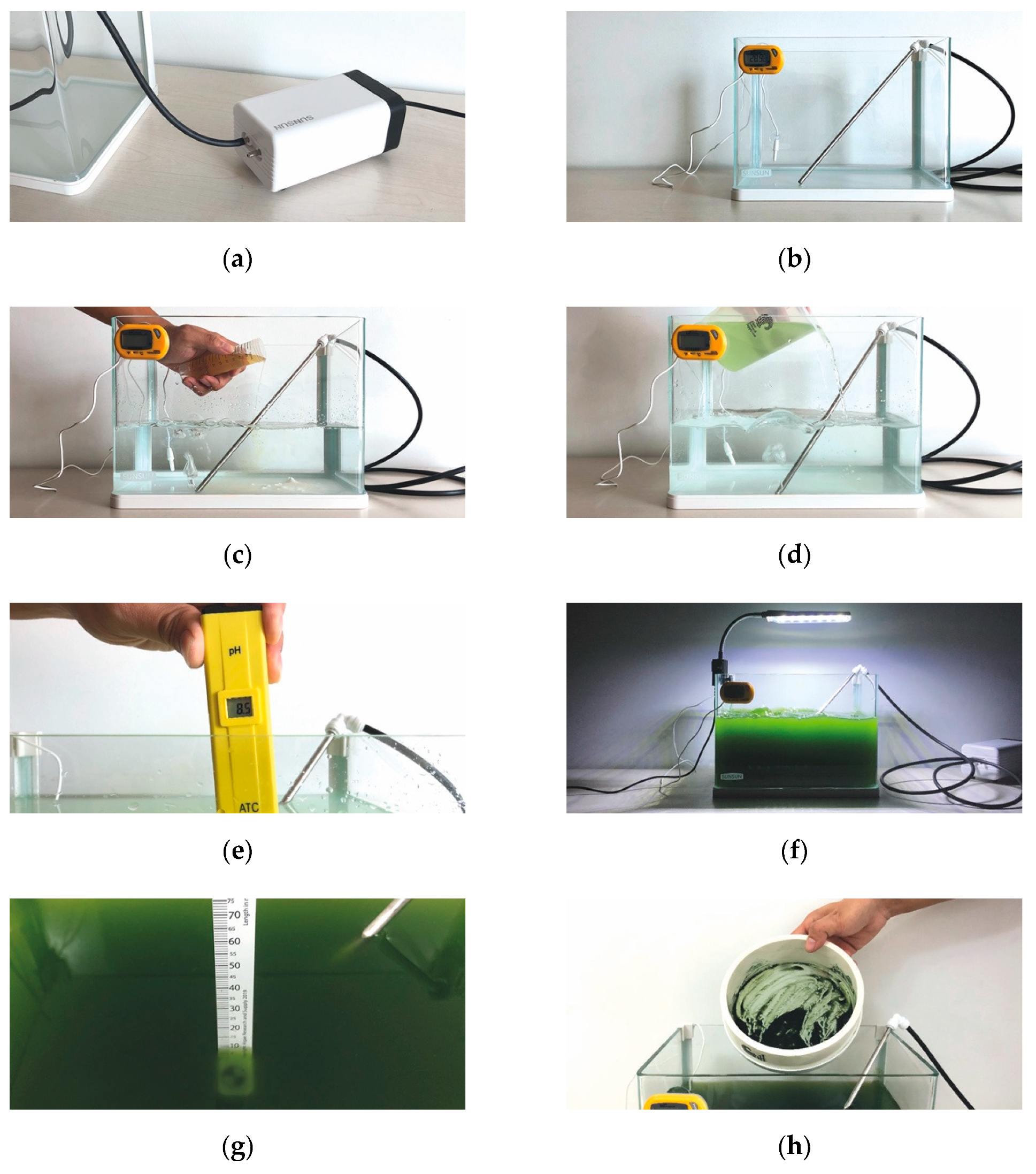
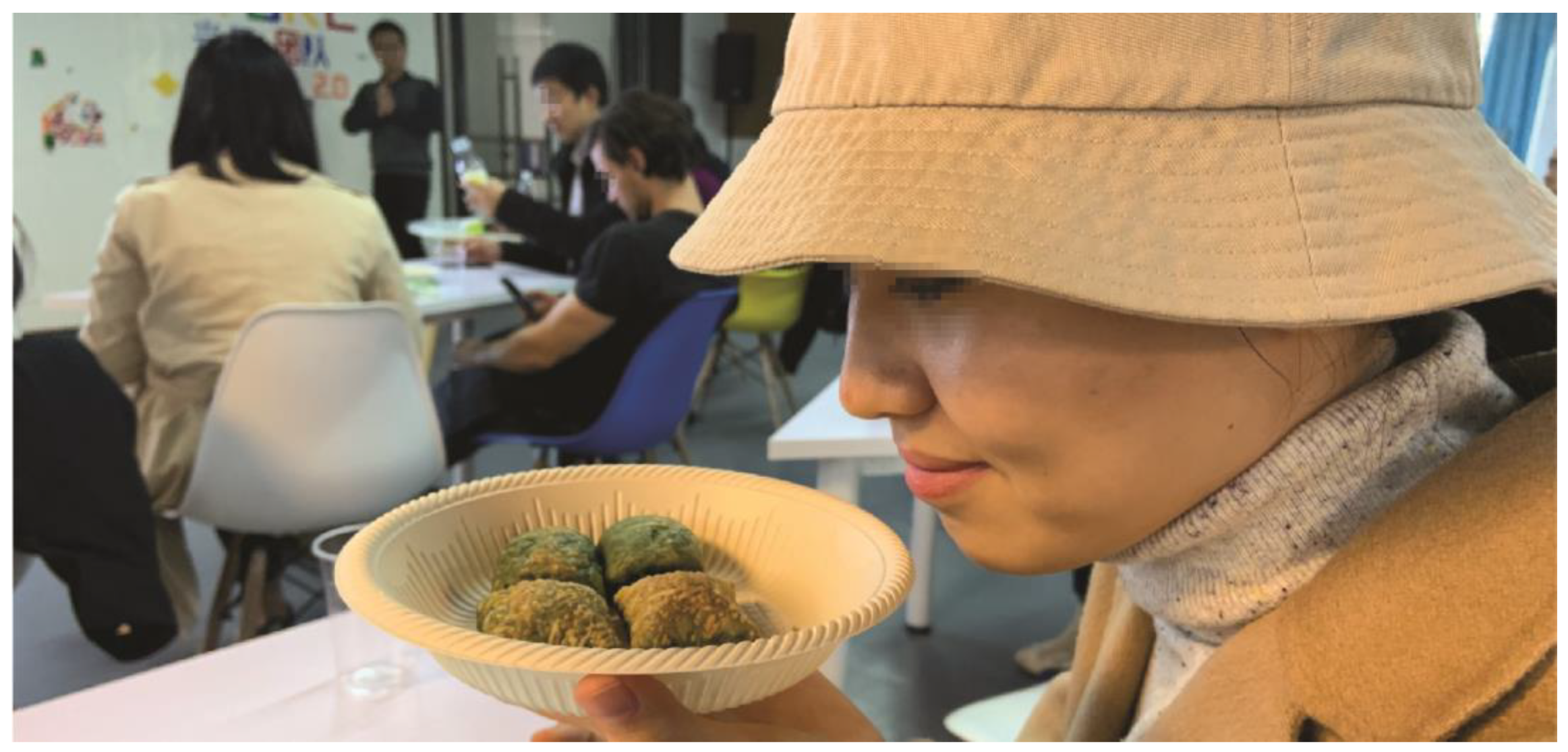
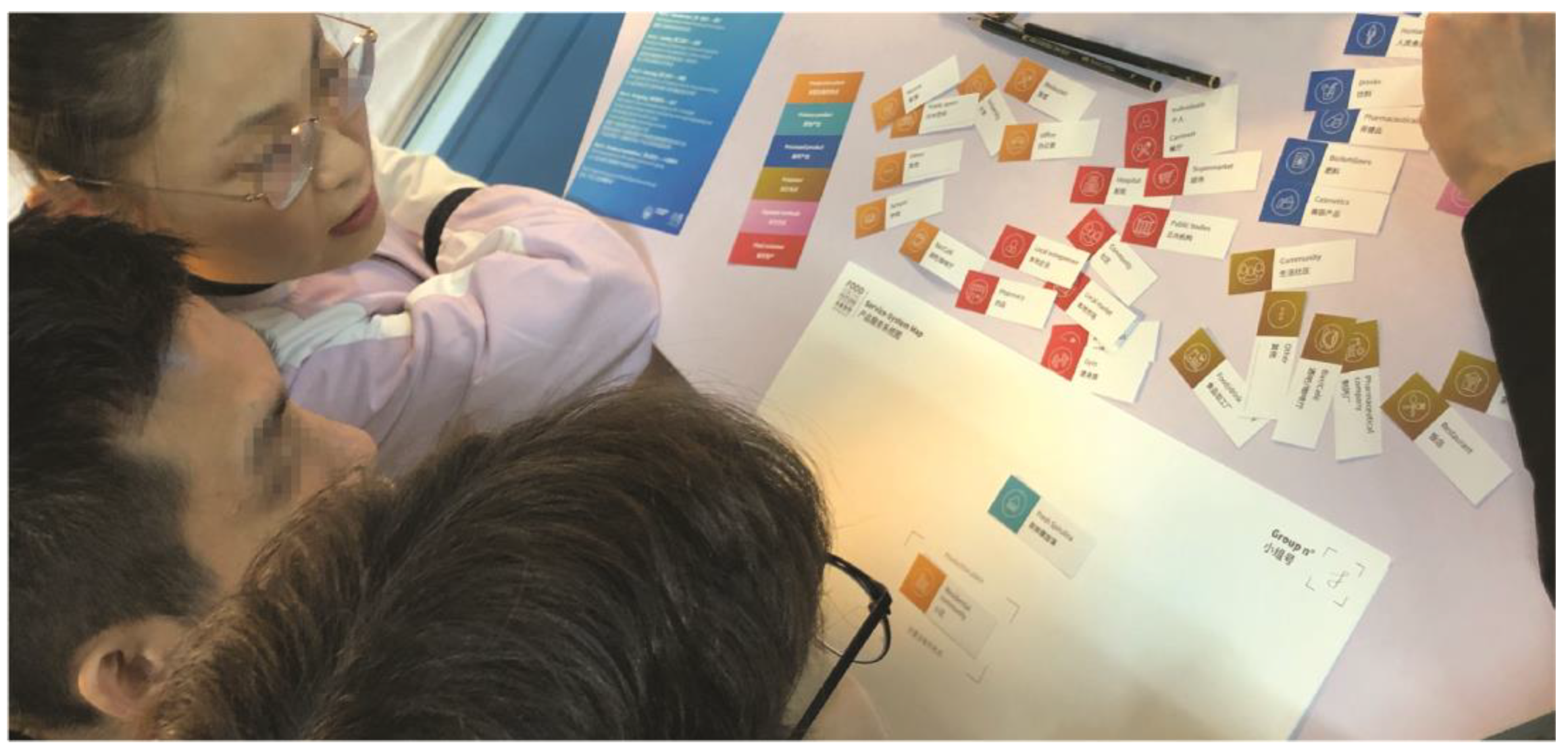
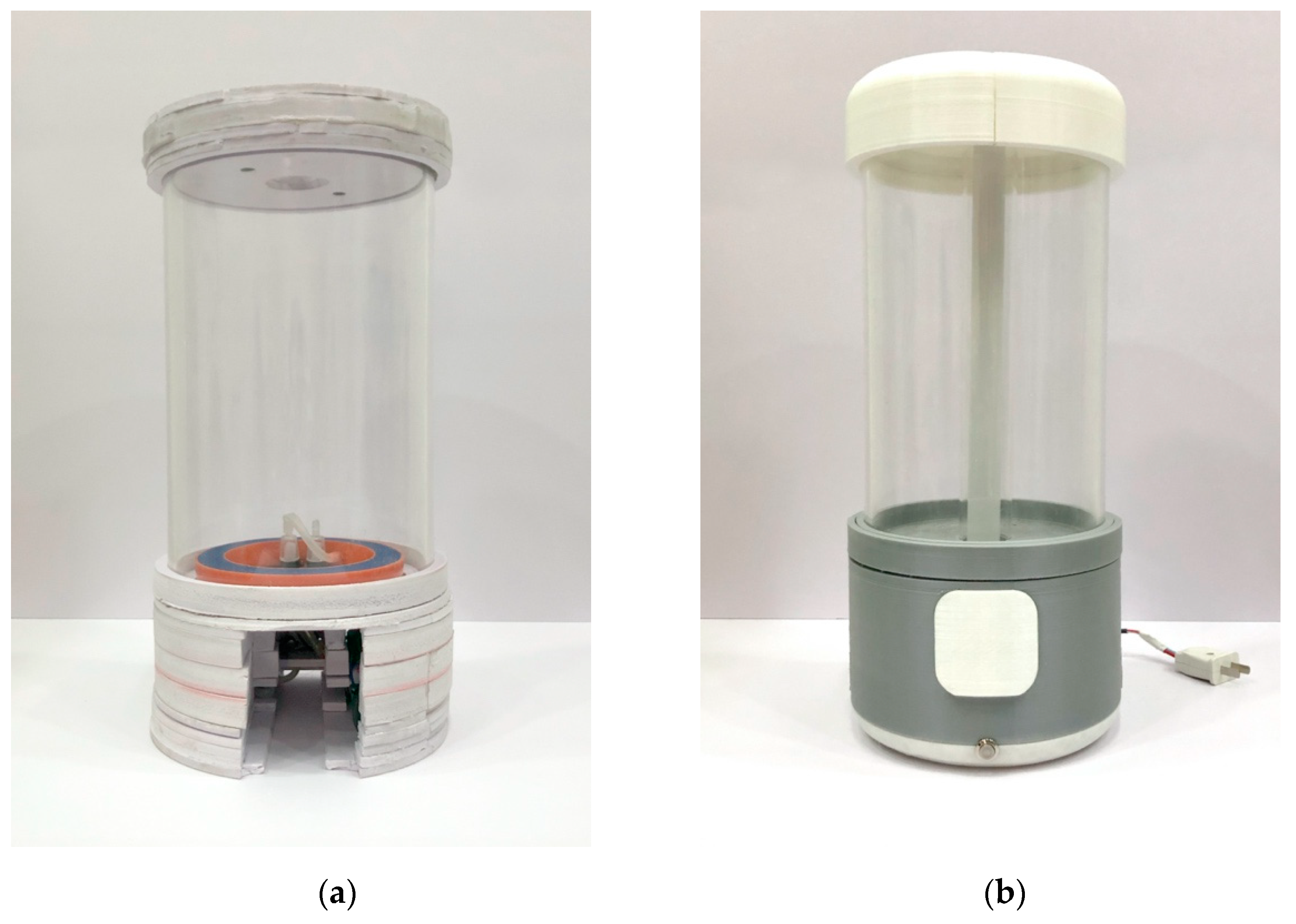
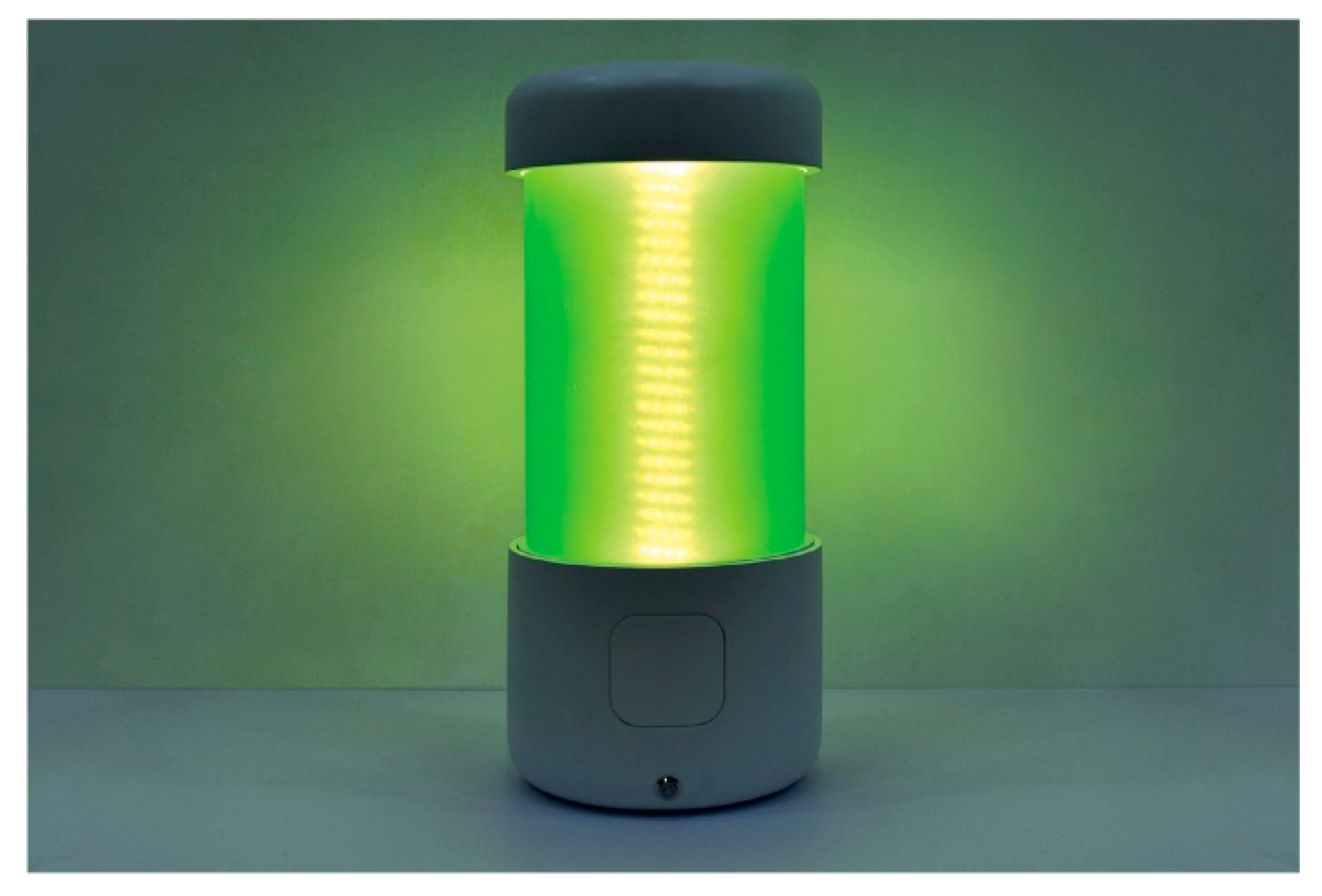
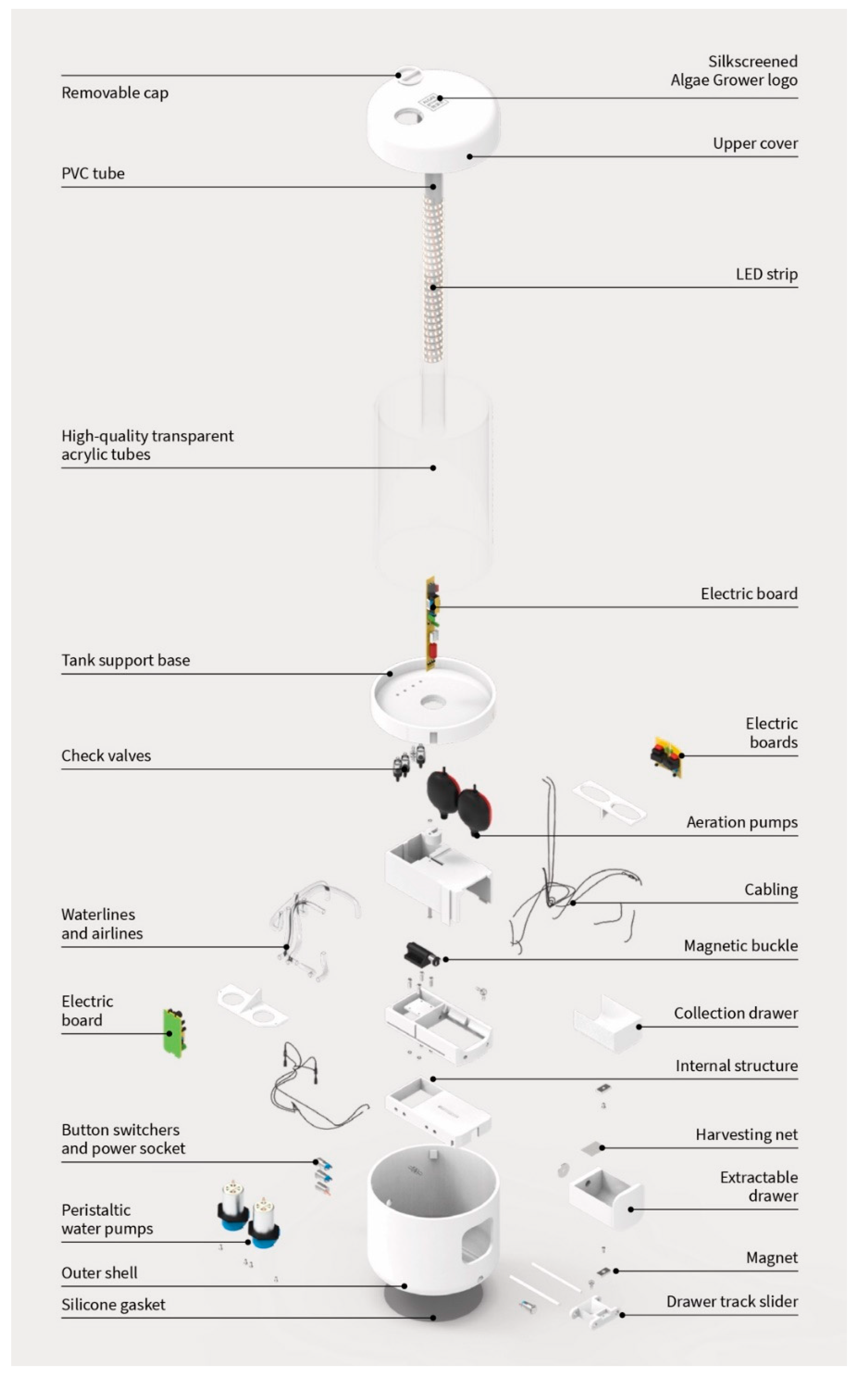
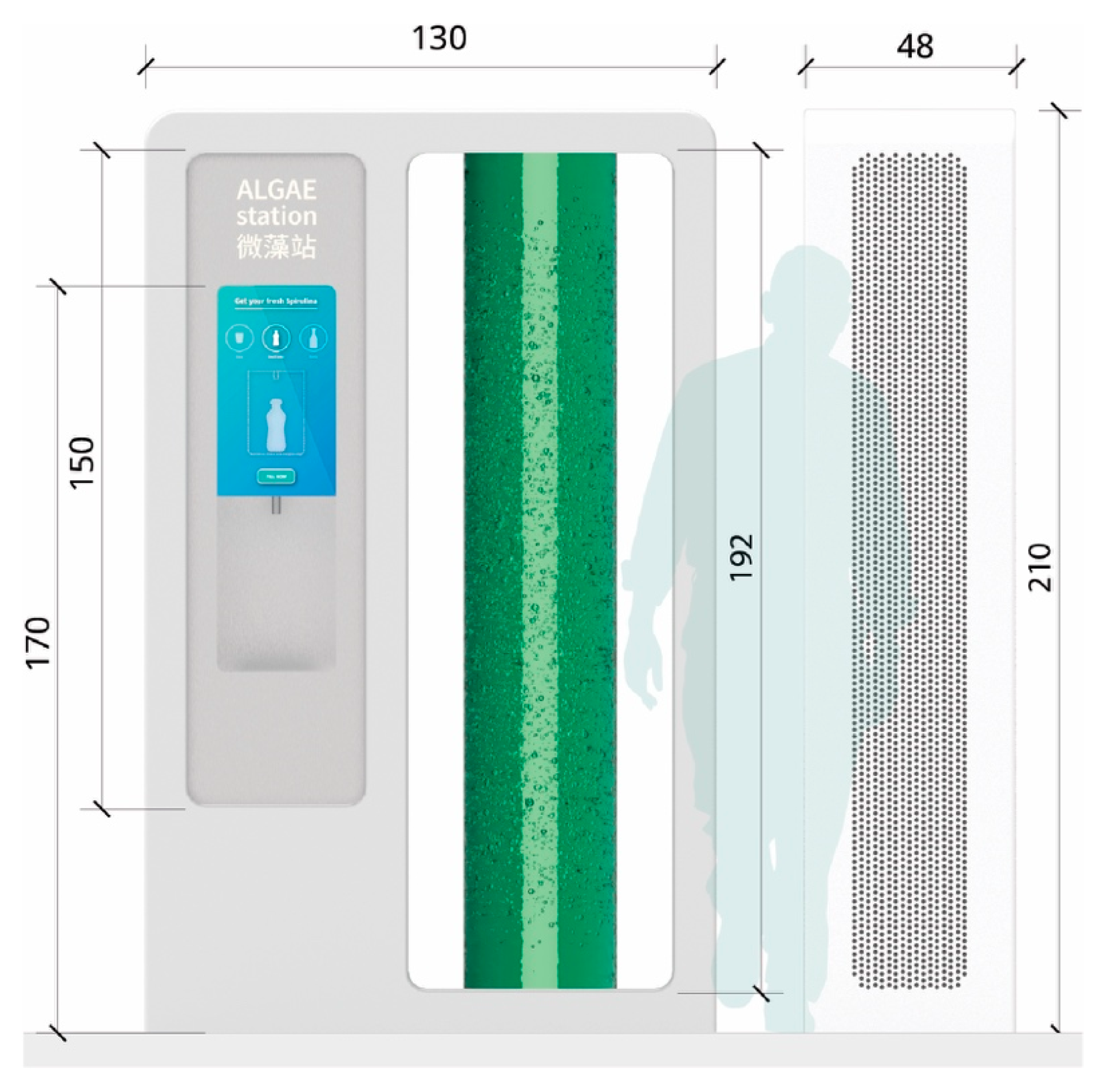
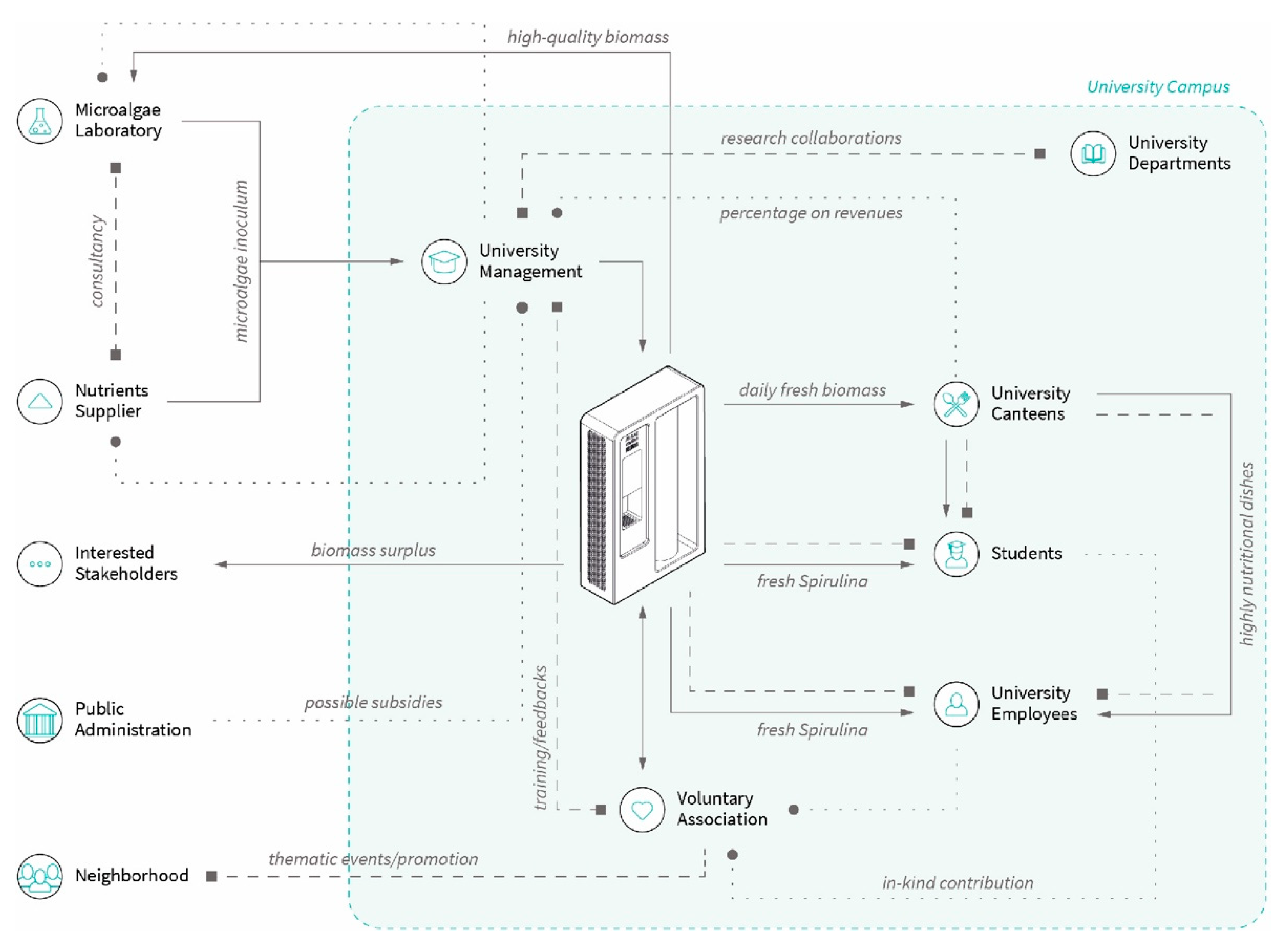
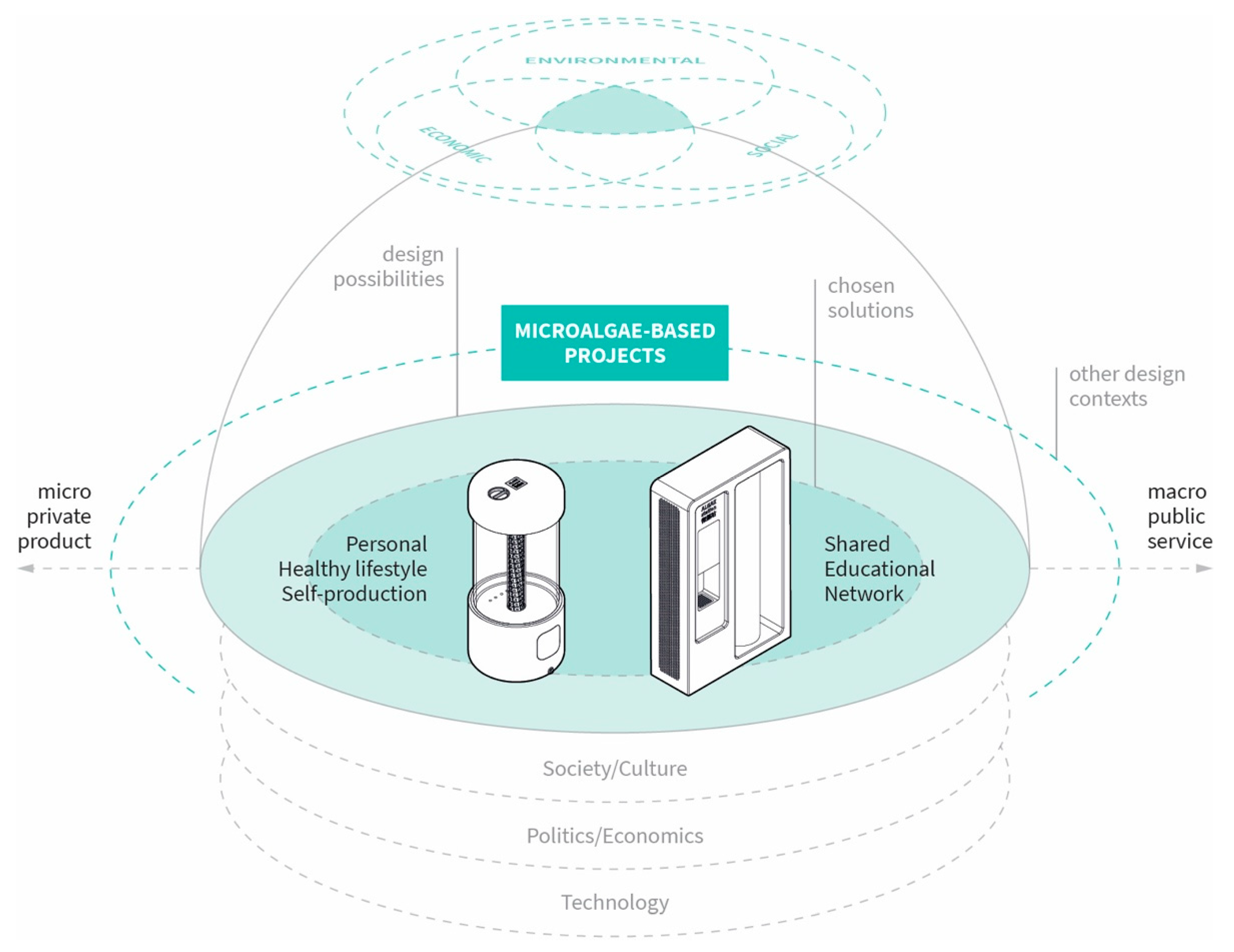
| Meal Replacements | Plant-Based Meat | Lab-Grown Meat | Insects | Mushrooms | Seaweed | Microalgae | |
|---|---|---|---|---|---|---|---|
| Type | synthetic | synthetic | synthetic | natural | natural | natural | natural |
| Presence in Diets | yes | partly | no | partly | yes | yes | partly |
| Nutritional Value | 3 | 3 | 2 | 3 | 3 | 3 | 4 |
| Acceptance | 3 | 3 | 2 | 1 | 4 | 3 | 3 |
| Palatability | 4 | 3 | 3 | 2 | 4 | 2 | 2 |
| Ethical/Cultural Issues | no | no | yes | yes | no | no | no |
| Production Price | 3 | 3 | 1 | 3 | 3 | 3 | 3 |
| Consumer Price | 2 | 2 | 1 | 4 | 3 | 3 | 3 |
| Processing Difficulty | 2 | 2 | 1 | 3 | 3 | 4 | 4 |
| Sustainability | 2 | 2 | 2 | 3 | 4 | 4 | 4 |
| Chance of Diffusion | 4 | 4 | 2 | 2 | 4 | 4 | 3 |
| Algae Curtain | Eco-Friendly Lamp | Living Things | Farma | Spirugrow | Symbiont | The Coral | |
|---|---|---|---|---|---|---|---|
| Main Scope | biofuel | CO2 capture | food/biofertilizer | drugs | food | CO2 capture | food |
| Dimensions | 1 | 2 | 2 | 3 | 3 | 2 | 2 |
| PBR Shape | tank/various | tubular | various | tubular | tank | tank | flat-panel |
| Production System | closed | closed | closed | closed | closed | closed | open |
| Harvesting System | manual | semi-automatic | manual | semi-automatic | semi-automatic | manual | manual |
| Productivity | 1 | 4 | 2 | 3 | 3 | 1 | 2 |
| Usability | 1 | 1 | 2 | 3 | 3 | 2 | 1 |
| Maintain-ability | 1 | 4 | 2 | 3 | 3 | 1 | 2 |
| Cost-effectiveness | 2 | 4 | 1 | 3 | 2 | 1 | 1 |
| Open-source | no | no | no | yes | no | no | no |
| Educational Value | 2 | 1 | 3 | 3 | 2 | 3 | 4 |
| Requirements | Performances | |
|---|---|---|
| Requirements for Use | Safe | Anchored stable structure. Smooth edges and corners. |
| Simple | Easy to interact with. Use of few colors and materials. | |
| Productive | Guarantee high yields while assuring freshness. | |
| Modular | Possibility for multiple configurations. | |
| Contextualized | Peculiar, still familiar appearance. | |
| Educative | Provide environmental benefits information. Arouse curiosity. | |
| Shared | Multiple ways of use. Universal accessibility. | |
| Operation Requirements | Movable | Easy to transport single parts. Facility to be assemble on-site. |
| Maintainable | Simple operations. Washable in all parts. | |
| Production Requirements | Simple | Basic production techniques. |
| Economic | Cheap to manufacture even in small-scale, local productions. | |
| Resistant | Resistant to all weather conditions. Vandal-resistant. | |
| Environmental Requirements | Efficient | Integrated systems for energy control and self-sustainability. |
| Durable | Long-lasting and strong, hard to break materials. |
| Day | Illumination | Bubbling | Temperature | pH | Density | Evaporation | Harvest |
|---|---|---|---|---|---|---|---|
| 1 | 1 h 20 min 1 | 4 h | 29.8 °C | 10.4 | 33 mm | 1 mm | - |
| 2 | 1 h 20 min | 4 h | 28.7 °C | 10.5 | 33 mm | 1 mm | - |
| 3 | 1 h 20 min | 4 h | 27.5 °C | 10.4 | 32 mm | 1 mm | - |
| 4 | 1 h 20 min | 4 h | 29.7 °C | 10.2 | 29 mm | 1 mm | - |
| 5 | 1 h 20 min | 4 h | 27.6 °C | 10.6 | 27 mm | 1 mm | - |
| 6 | 6h | 6 h | 37.3 °C | 10.4 | 25 mm | 2 mm | - |
| 7 | 6h | 6 h | 37.5 °C | 10.8 | 18 mm | 1 mm | - |
| 8 | 6h | 6 h | 37.4 °C | 10.8 | 13 mm | 2 mm | - |
| 9 | 6 h | 6 h | 37.6 °C | 11.0 | 10 mm | 2 mm | - |
| 10 | 4 h | 4 h | 37.2 °C | 11.1 | 9 mm | 1 mm | - |
| 11 | 4 h | 4 h | 37.1 °C | 11.3 | 8 mm | 1 mm | - |
| 12 | 4 h | 4 h | 37.3 °C | 11.1 | 4 mm | 2 mm | 5.2 g |
| 13 | 4 h | 4 h | 37.4 °C | 11.2 | 3 mm | 1 mm | 5.3 g |
| 14 | 4 h | 4 h | 37.2 °C | 10.9 | 4 mm | 2 mm | 5.0 g |
| 15 | 6 h | 6 h | 37.8 °C | 10.8 | 4 mm | 1 mm | 5.7 g |
| 16 | 6 h | 6 h | 37.9 °C | 11.1 | 5 mm | 1 mm | 5.3 g |
| 17 | 6 h | 6 h | 37.7 °C | 11.2 | 4 mm | 2 mm | 5.5 g |
| 18 | 6 h | 6 h | 37.5 °C | 11.1 | 5 mm | 1 mm | 5.2 g |
| 19 | 6 h | 6 h | 37.8 °C | 11.1 | 4 mm | 2 mm | 5.2 g |
| 20 | 6 h | 6 h | 37.7 °C | 11.1 | 5 mm | 1 mm | 5.0 g |
| 21 | 6 h | 6 h | 37.5 °C | 11.1 | 5 mm | 1 mm | 5.7 g |
Publisher’s Note: MDPI stays neutral with regard to jurisdictional claims in published maps and institutional affiliations. |
© 2021 by the authors. Licensee MDPI, Basel, Switzerland. This article is an open access article distributed under the terms and conditions of the Creative Commons Attribution (CC BY) license (http://creativecommons.org/licenses/by/4.0/).
Share and Cite
Vrenna, M.; Peruccio, P.P.; Liu, X.; Zhong, F.; Sun, Y. Microalgae as Future Superfoods: Fostering Adoption through Practice-Based Design Research. Sustainability 2021, 13, 2848. https://doi.org/10.3390/su13052848
Vrenna M, Peruccio PP, Liu X, Zhong F, Sun Y. Microalgae as Future Superfoods: Fostering Adoption through Practice-Based Design Research. Sustainability. 2021; 13(5):2848. https://doi.org/10.3390/su13052848
Chicago/Turabian StyleVrenna, Maurizio, Pier Paolo Peruccio, Xin Liu, Fang Zhong, and Yuchi Sun. 2021. "Microalgae as Future Superfoods: Fostering Adoption through Practice-Based Design Research" Sustainability 13, no. 5: 2848. https://doi.org/10.3390/su13052848
APA StyleVrenna, M., Peruccio, P. P., Liu, X., Zhong, F., & Sun, Y. (2021). Microalgae as Future Superfoods: Fostering Adoption through Practice-Based Design Research. Sustainability, 13(5), 2848. https://doi.org/10.3390/su13052848






